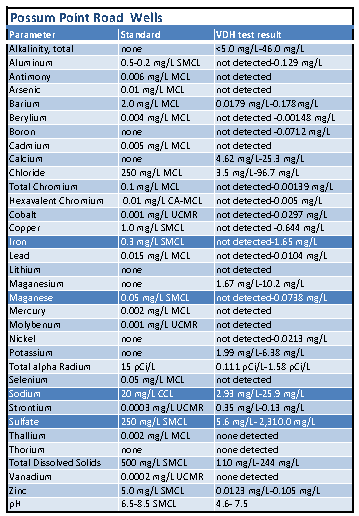However, there was concern that trace contaminants and metals in the coal ash may have already leached into the groundwater, Quantico Creek and Potomac, though the residential wells are all up gradient (the groundwater naturally flows to the bay) of the coal ash ponds and separated by an unnamed tributary known to the residents as “Beaver Pond” which would under most circumstances act as a hydraulic barrier between the coal ash ponds and the residences. In other words the hydrology of the area would tend to act to protect the homeowners’ wells from contamination for the power plant. In addition, groundwater in Prince William County tends to be very “young” depending on the depth of the well.
The VDH sampled the wells on three different days; on February 23rd 2016 (1 well), March 1, 2016 (4 wells) and March 7th 2016 (1 well). All the wells were sampled from an outdoor spigot or from a tap before treatment close to the well head after purging 20 gallons to 44 gallons. The goal was to test the underlying aquifer not the impact to water sitting in pipes for several hours. There is no information provided about the wells themselves. The type, age, depth of the well, and the recharge rate are unreported.
Four of the six wells had water that was slightly acidic and though the flushed water samples from the point tested was below the MCL for lead of 15 ppb, as the VDH points out there are many who believe that there is no safe level for lead, especially since the VDH for the most part tested an outdoor spigot and did not measure the impact of the household plumbing to flushed lead levels. Flushing 20-44 gallons would not flush the water from the well column itself. So the lead found present in the 4 wells with acidic water was likely from the well and pump fittings which historically have contained up to 8% lead in the brass. Well columns contain (typically) about 1.5 gallons per foot so it is likely that the VDH was sampling water that had been stored in the well for an unknown period of time.
In the water clinics we find elevated levels of lead often occur in homes with acidic water. While the presence of low levels of lead in the home with acidic water (a pH of 4.85-5.79) is of concern for long term health of the occupants, it is not an indication of impact from the Dominion coal ash ponds. This commonly occurs throughout the county and the Commonwealth. Other findings of concern were VDH discover that one of the wells had a large opening in its lid which presents a significant contamination risk for bacterial contamination as well as insects and small animals. Another well was reported to be in the basement of the home. This well does not meet the current state well construction regulations or the old 1979 county well regulations. Finally, there were significant elevations of sodium, sulfate, iron, and manganese substances that are naturally occurring and can make well water quite unpleasant. (The complete results can be obtained via a FOIA request.)
